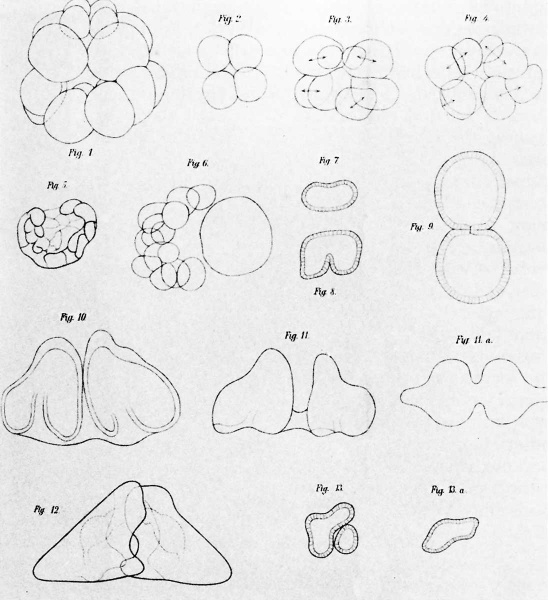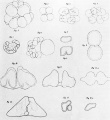File:Hilfer1990 Fig05.jpg

Original file (1,096 × 1,200 pixels, file size: 93 KB, MIME type: image/jpeg)
Figure 5. H. Driesch manipulating blastomeres of sea urchin eggs
Illustrations from H. Driesch (1892) showing effects of manipulating blastomeres of sea urchin eggs. His Figure 1 shows a normal 16-cell stage (copied from Selenka). Figure 2 shows a half-embryo from an 8-cell stage and Figures 3 and 4 half-embryos from a 16-cell stage. Figure 5 is a half-embryo at the blastula stage. These half-embryos developed into complete individuals. Figures 7 through 9 show blastulae in the process of dividing. These formed conjoined twins as shown in Figures 10 through 12. These results were interpreted as demonstrating regulative development.
(Courtesy of the Marine Biological Laboratory.)
Hans Adolf Eduard Driesch (1867 - 1941) was a German developmental biologist.
- Figures: Fig 1. by N. Hartsoeker 1694 | Fig 2. by M. Malpighi 1673 | Fig 3. by C.E. von Baer 1827 | Fig 4. by W. Roux 1888 | Fig 5. by H. Driesch 1892 | Fig 6. Louis Agassiz | Fig 7. Leonard W. Williams c1900 | Fig 8. by Conklin 1905 | Fig 9. by Wilson 1892 | Fig 10. by Loeb 1893 | Fig 11. by E. B. Wilson 1904 | Fig 12. by O.E. Schotte | Fig 13. by Spemann and H. Mangold 1924 | Fig 14. by S. Horstadius 1928 | Fig 15. by R. G. Harrison 1921 | Fig 16. by Townes and Holtfreter 1955
Cite this page: Hill, M.A. (2024, April 27) Embryology Hilfer1990 Fig05.jpg. Retrieved from https://embryology.med.unsw.edu.au/embryology/index.php/File:Hilfer1990_Fig05.jpg
- © Dr Mark Hill 2024, UNSW Embryology ISBN: 978 0 7334 2609 4 - UNSW CRICOS Provider Code No. 00098G
File history
Click on a date/time to view the file as it appeared at that time.
| Date/Time | Thumbnail | Dimensions | User | Comment | |
|---|---|---|---|---|---|
| current | 09:26, 28 August 2014 |  | 1,096 × 1,200 (93 KB) | Z8600021 (talk | contribs) | ==Figure 5. == Illustrations from H. Driesch (1892) showing effects of manipulating blastomeres of sea urchin eggs. His Figure 1 shows a normal 16-cell stage (copied from Selenka). Figure 2 shows a half-embryo from an 8-cell stage and Figures 3 and 4... |
You cannot overwrite this file.
File usage
The following 3 pages use this file: